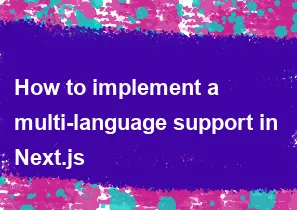How to use Laravel Echo for broadcasting events with ReactJS

Laravel Echo is a powerful tool that allows you to work with real-time events and broadcasting in Laravel applications. When using ReactJS as your frontend framework, you can integrate Laravel Echo to listen for and react to events broadcasted from the Laravel backend.
Here's a step-by-step guide on how to use Laravel Echo for broadcasting events with ReactJS:
Install Laravel Echo and Pusher: Ensure that you have Laravel Echo and a broadcasting service like Pusher set up in your Laravel application. You can install them using Composer:
bashcomposer require pusher/pusher-php-serverAlso, configure your
.envfile with your Pusher credentials:envBROADCAST_DRIVER=pusher PUSHER_APP_ID=your-app-id PUSHER_APP_KEY=your-app-key PUSHER_APP_SECRET=your-app-secret PUSHER_APP_CLUSTER=your-app-clusterInstall Echo and Socket.IO for React: You will need to install the necessary packages for Laravel Echo and Socket.IO in your React application:
bashnpm install --save laravel-echo socket.io-clientConfigure Echo in React: In your React application, set up Laravel Echo by creating an Echo instance in a central location (e.g.,
src/echo.js):jsximport Echo from 'laravel-echo'; import io from 'socket.io-client'; const echo = new Echo({ broadcaster: 'socket.io', host: window.location.hostname + ':6001', // Your Laravel Echo server's host client: io, }); export default echo;Use Echo in React Components: Now, you can use the
echoinstance in your React components to listen for events. For example, in a React component:jsximport React, { useEffect } from 'react'; import echo from './echo'; const MyComponent = () => { useEffect(() => { echo.channel('my-channel') .listen('MyEvent', (event) => { console.log('Event received:', event); // Handle the event data here }); }, []); return ( <div> {/* Your component content */} </div> ); }; export default MyComponent;Broadcast Events in Laravel: In your Laravel application, whenever you want to broadcast an event, you can use Laravel's broadcasting features. For example, in a controller or other relevant part of your code:
phpuse Illuminate\Support\Facades\Broadcast; // ... public function someAction() { // Your action logic $data = ['key' => 'value']; // Data to be sent with the event Broadcast::event(new MyEvent($data)); // ... }Ensure that you have created the event class (
MyEventin this example) that extendsShouldBroadcast.Run Laravel Echo Server: Start the Laravel Echo server to handle broadcasting. Run the following command in your Laravel project:
bashphp artisan websockets:serveThis assumes you have the
beyondcode/laravel-websocketspackage installed.Run React Application: Start your React application:
bashnpm startEnsure that your React application is running on the same domain as your Laravel application to avoid cross-origin issues.
Now, when events are broadcasted from your Laravel backend, your React components should receive and handle them appropriately. Adjust the event names, channels, and data according to your application's needs.
-
Popular Post
- How to optimize for Google's About This Result feature for local businesses
- How to implement multi-language support in an Express.js application
- How to handle and optimize for changes in mobile search behavior
- How to handle CORS in a Node.js application
- How to use Vue.js with a UI framework (e.g., Vuetify, Element UI)
- How to configure Laravel Telescope for monitoring and profiling API requests
- How to create a command-line tool using the Commander.js library in Node.js
- How to implement code splitting in a React.js application
- How to use the AWS SDK for Node.js to interact with various AWS services
- How to use the Node.js Stream API for efficient data processing
- How to implement a cookie parser middleware in Node.js
- How to implement WebSockets for real-time communication in React
-
Latest Post
- How to implement a dynamic form with dynamic field styling based on user input in Next.js
- How to create a custom hook for handling user interactions with the browser's device motion in Next.js
- How to create a custom hook for handling user interactions with the browser's battery status in Next.js
- How to implement a dynamic form with dynamic field visibility based on user input in Next.js
- How to implement a dynamic form with real-time collaboration features in Next.js
- How to create a custom hook for handling user interactions with the browser's media devices in Next.js
- How to use the useSWRInfinite hook for paginating data with a custom loading indicator in Next.js
- How to create a custom hook for handling user interactions with the browser's network status in Next.js
- How to create a custom hook for handling user interactions with the browser's location in Next.js
- How to implement a dynamic form with multi-language support in Next.js
- How to create a custom hook for handling user interactions with the browser's ambient light sensor in Next.js
- How to use the useHover hook for creating interactive image zoom effects in Next.js